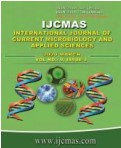


 National Academy of Agricultural Sciences (NAAS)
National Academy of Agricultural Sciences (NAAS)

|
PRINT ISSN : 2319-7692
Online ISSN : 2319-7706 Issues : 12 per year Publisher : Excellent Publishers Email : editorijcmas@gmail.com / submit@ijcmas.com Editor-in-chief: Dr.M.Prakash Index Copernicus ICV 2018: 95.39 NAAS RATING 2020: 5.38 |
Neonatal sepsis is defined as a bacterial infection of the blood in an infant younger than 4 weeks of age. Blood cultures remain the mainstay of laboratory diagnosis of bloodstream infections (BSIs) in infants. The knowledge of bacteriological profile and its antibiotic sensitivity patterns is of immense help in saving lives of neonates with septicaemia. The study was conducted on neonatal blood samples to identify the common pathogens as well as rare and newer pathogenic species causing neonatal septicaemia along with their antibiotic sensitivity to help formulate guidelines for empiric antibiotic therapy in a developing country. A retrospective study was carried out on neonatal septicaemia for a period of two years from 2018 to 2019 on total 746 blood samples of neonates from konkan region at a private Microbiology lab in North Goa. Blood samples were processed for identification of pathogens along with antibiotic sensitivity by BACTEC and VITEK automated machines. Out of the 746 blood samples received 77 (10.3 %) samples showed growth of pathogenic organisms. 65 isolates were gram negative and 12 were gram positive. Amongstgram negative organisms Klebsiellapneumonia (28.6%) and Pseudomonas species (24.7%) were most commonly isolated and amongst the gram positive were CONS (5.2%) and MRSA (3.9%).Pandorea species and Ralstoniapickettii were the newer pathogens isolated. Gram negative organisms showed highest resistance to Beta lactamase inhibitors (86.7 %), Cephalosporins (75.6%)and Gentamicin (75.4%)and sensitivity to Carbapenemes and Colistin whereas gram positive organisms showed overall resistance to Beta lactam inhibitor Benzyl Penicillin (83.3%) and to Ciprofloxacin (66.7%) and sensitivity to Glycopeptides like Teicoplanin and Vancomycin. Resistance of common pathogens to multiple antimicrobial agents along with emergence of newer pathogens is a great challenge to the effective management of neonatal septicaemia, hence formulation of rational antibiotic policy is important to guide the clinicians regarding both the empirical and definitive treatment.
 |
 |
 |
 |
 |